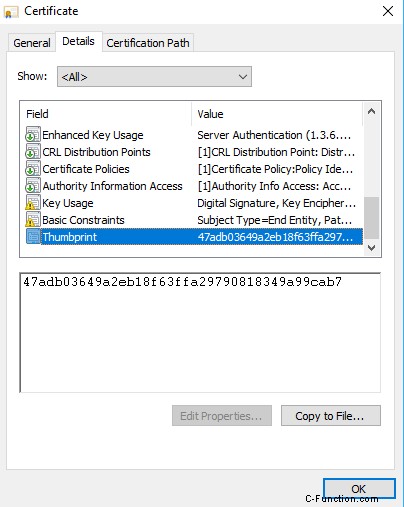C# Ignorare gli errori del certificato?
Aggiungi un gestore di convalida del certificato. Restituendo true consentirà di ignorare l'errore di convalida:
ServicePointManager
.ServerCertificateValidationCallback +=
(sender, cert, chain, sslPolicyErrors) => true;
Consentire tutti i certificati è molto potente ma potrebbe anche essere pericoloso. Se desideri consentire solo certificati validi più alcuni certificati, puoi farlo in questo modo.
.Nucleo netto:
using (var httpClientHandler = new HttpClientHandler())
{
httpClientHandler.ServerCertificateCustomValidationCallback = (message, cert, chain, sslPolicyErrors) => {
if (sslPolicyErrors == SslPolicyErrors.None)
{
return true; //Is valid
}
if (cert.GetCertHashString() == "99E92D8447AEF30483B1D7527812C9B7B3A915A7")
{
return true;
}
return false;
};
using (var httpClient = new HttpClient(httpClientHandler))
{
var httpResponse = httpClient.GetAsync("https://example.com").Result;
}
}
.Network:
System.Net.ServicePointManager.ServerCertificateValidationCallback += delegate (
object sender,
X509Certificate cert,
X509Chain chain,
SslPolicyErrors sslPolicyErrors)
{
if (sslPolicyErrors == SslPolicyErrors.None)
{
return true; //Is valid
}
if (cert.GetCertHashString() == "99E92D8447AEF30483B1D7527812C9B7B3A915A7")
{
return true;
}
return false;
};
Aggiornamento:
Come ottenere cert.GetCertHashString() valore in Chrome:
Clicca su Secure o Not Secure nella barra degli indirizzi.


Quindi fare clic su Certificato -> Dettagli -> Identificazione personale e copiare il valore. Ricordati di fare cert.GetCertHashString().ToLower() .

Metodo IgnoreBadCertificates:
//I use a method to ignore bad certs caused by misc errors
IgnoreBadCertificates();
// after the Ignore call i can do what ever i want...
HttpWebRequest request_data = System.Net.WebRequest.Create(urlquerystring) as HttpWebRequest;
/*
and below the Methods we are using...
*/
/// <summary>
/// Together with the AcceptAllCertifications method right
/// below this causes to bypass errors caused by SLL-Errors.
/// </summary>
public static void IgnoreBadCertificates()
{
System.Net.ServicePointManager.ServerCertificateValidationCallback = new System.Net.Security.RemoteCertificateValidationCallback(AcceptAllCertifications);
}
/// <summary>
/// In Short: the Method solves the Problem of broken Certificates.
/// Sometime when requesting Data and the sending Webserverconnection
/// is based on a SSL Connection, an Error is caused by Servers whoes
/// Certificate(s) have Errors. Like when the Cert is out of date
/// and much more... So at this point when calling the method,
/// this behaviour is prevented
/// </summary>
/// <param name="sender"></param>
/// <param name="certification"></param>
/// <param name="chain"></param>
/// <param name="sslPolicyErrors"></param>
/// <returns>true</returns>
private static bool AcceptAllCertifications(object sender, System.Security.Cryptography.X509Certificates.X509Certificate certification, System.Security.Cryptography.X509Certificates.X509Chain chain, System.Net.Security.SslPolicyErrors sslPolicyErrors)
{
return true;
}